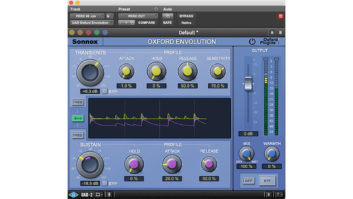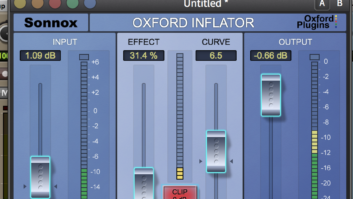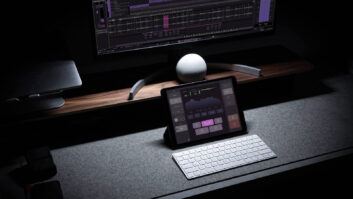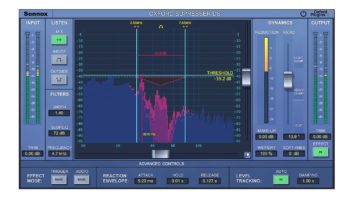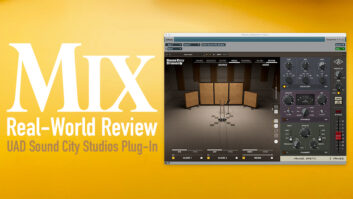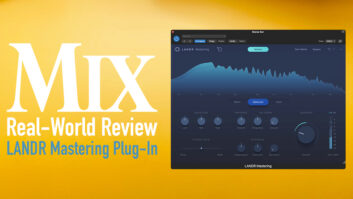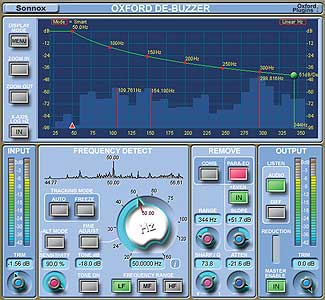
The Restore restoration suite from Sonnox is the result of 18 months of research into developing new tools that exploit recent advances in computer and software technologies. This Native suite comprises DeClicker, DeBuzzer and DeNoiser, which are available in RTAS (for Pro Tools HD, LE and M-Powered systems), Audio Units and VST formats for Mac and PC.
Completely unrelated to the old Sony Restoration Tools and offering no backward compatibility, each plug-in uses a two-step methodology, with a detection section for pinpointing problematic and unwanted noise and a removal section that determines the desired level of repair while minimizing collateral damage to the original audio. Each plug-in offers common functions, including an output section with enable in/out, output level adjust, threshold and sensitivity settings, and a Diff (or Difference) button for monitoring the removal of the targeted noise.
DeBuzzer removes buzzes, hums, whines and whistles.
DeClicker
DeClicker is divided into three sections, each of which is designed to remove impulse noises predicated on duration. DePop is for noises lasting up to 10ms long, DeClick for 3 ms, and DeCrackle for 0.4 ms. Each section in DeClicker has a mini-display that shows the noise floor and a threshold line with the impulses either above or below it. There is a larger, clever X/Y graphic display that shows each individual noise spike as a color-coded bubble: DePop events are green, DeClick events are blue and DeCrackle noises are white, with unrepaired noises glowing red. In the event that DeClicker removes important harmonic content such as percussive transients or the brightness of a brass section while otherwise repairing well, there is the Exclude Box feature.
Rather than simply bypassing or changing the threshold setting for that particular piece of the audio that would affect the rest of DeClicker’s repair, you can use your mouse as a “lasso” around a grouping of bubbles that represent the impulses you want and exclude them from repair. Because the Restore Suite plug-ins’ parameters are all automatable, you can move Exclude Boxes and toggle them in and out invisibly.
Unique to DeClicker is the Dialog mode, in which one threshold is set for processing background noise when dialog audio is present and there’s another threshold setting for when it is not. The Dialog mode GUI has a histogram of the dialog audio over time with two adjustable horizontal threshold lines. When the dialog audio exceeds the top threshold, it is processed according to the controls labeled Above. When dialog has stopped and falls below threshold, the plug-in switches over to repairing according to the controls labeled Below. If required, the Sidechain mode adds an adjustable bandpass filter to further differentiate the frequencies of dialog audio from background noise.
DeBuzzer
DeBuzzer detects and accurately measures the fundamental and harmonic frequencies of buzzes, hums, whines and whistles, and passes this information on to the removal section. Using an FFT (Fast Fourier Transform) display that accumulates data over time, a peak profile is created and shown in a small display above a large rotary frequency adjust knob.
In Manual mode, turning this knob will set the fundamental frequency of the buzz over any of the three frequency ranges: LF, MF or HF. Any buzz or hum that is consistently present will stand out on the main FFT display with its three dominant peaks marked with red arrows. Clicking on any of these arrows will reset the fundamental for the removal section to recalculate the coefficients for the comb filter to remove it and its harmonics.
When you insert DeBuzzer into your session, it defaults to Auto mode where the detector continuously “hunts” either side of the fundamental to check for drift in frequency; the removal filters will follow. Freeze mode turns off this hunting process and is the best way to dial in whines or whistle noises in the MF or HF areas.
In addition to the comb filter, DeBuzzer also offers the Para-EQ mode. Generally, the narrow and deep notches of the comb filter do less damage to high frequencies and are the best for harmonically rich buzzes. But if you have only one or two harmonics to remove and the fundamental is above 2 kHz — such as a loud whistle — the Para-EQ might sound better.
DeNoiser
DeNoiser automatically looks at the audio’s dynamics and frequency changes to detect and remove broadband noise. It scans the audio spectrum for signals that are consistently always present. A noise profile is then derived and used to remove components of the frequency spectrum that are below a predetermined threshold. Auto mode compensates for dynamics in the desired audio by always keeping the removed noise a fixed number of decibels below the desired audio level; even if the audio dips near the noise floor, it will not be removed with the noise.
Freeze mode grabs the current noise profile from Auto and uses it to remove the same amount of noise at all times. If the desired audio gets louder, removal is less destructive, but as the audio gets quieter, you’ll start to hear it being removed with the noise.

Mom DeBuzzer
An experienced restoration engineer could use DeNoiser’s third mode, Manual, to lock in a specific noise profile. Because all controls are automatable, this may be the most meticulous way to ensure the best restoration throughout a widely varying audio program.

Mom DeNoiser
For additional manual control over the noise threshold profile, there is a Threshold Bias Curve colored red in the GUI that offers 17 frequency steps. These curves with handles allow for frequency-dependent threshold settings on critical frequencies. You can raise threshold in the more important midrange frequencies of a vocal track and lower threshold in the less-important high and low frequencies for more removal.

78 rpm DeClicker
Likewise, the removal section also has a 17-step Noise-Reduction Bias curve that is colored in yellow. The experienced audio restorer can produce more musical results by reducing noise in frequency areas of less impact to the fidelity of the overall audio program, thus respecting its character and ambience.

78 rpm DeNoiser
DeNoiser finishes with a DeHisser section — an aggressive lowpass filter that’s good for rolling off bright tape hiss or surface noise in dialog or old film recordings. The Warmth control adds richness to the sound otherwise lost due to noise reduction. This feature is subtle but good.

Viola DeRumble
Install and Rejuvenate

Viola DeClicker
I installed Restore into my Pro Tools HD3 Accel system running Pro Tools Version 7.4 on a quad-core Mac PowerPC and found all three plug-ins’ real-time processors. You can insert and use them in multitrack sessions like any other plug-in. However, they use a considerable amount of CPU resources, depending on their settings, and require that you set Pro Tools’ DAE buffer at 1,024 samples. They also exhibit latencies that are generally beyond the capabilities of Pro Tools’ Automatic Delay Compensation engine.

Viola DeNoiser
There are no set rules concerning which noise(s) to remove first; this decision is part of the educable craft and experiential art of audio restoration. Most restorers “climb the highest mountain first” by removing the loudest noises first so as to unmask lower-level background trash.
I found it was best to use AudioSuite or record each plug-in’s processed audio to a new track. In general, I found that the default settings were very close to exactly what I needed, and if they weren’t, there are many presets that can get you into the “sweet spot” quickly.
Cleaning Up My History
My first job was cleaning a narration track for an oral history with my 97-year-old mother. For the most part, the recordings are clean with minimal background noise — until the air conditioner started. In addition to the broadband noise of rushing air, there was also the steady whining sound of the motor.
I first used DeBuzzer to find and remove the whine at 258.750 Hz, plus components at approximately 417 and 460 Hz. In Auto mode, DeBuzzer “homed in” on the whine instantly and continued tracking as the A/C motor’s whine changed pitch. Listen now.
I continued processing using DeNoiser to remove the broadband air-rushing noise; I bypassed DeHisser because it was not needed. Removing broadband noise is a compromise between how much noise is removed and making my mom sound like she is coming from the moon and back over a single-sideband shortwave radio.
I ended up using both the Threshold and Noise-Reduction Bias curves. I dipped threshold at 1 kHz, where the A/C noise was strong but masked by her audio, and then scaled back on the reduction at 6 kHz and 8 kHz to keep things bright enough. I’m just beginning with the restoration, so it probably could all be better. Listen now.
78 rpm Audio
I found a completely different set of problems in a digital copy of a 78 rpm record from the 1940s. On its first instantiation, DeClicker was 80 percent effective. DeClicker grabbed a lot of clicks from the vinyl record with its Threshold at 6.7 percent and Sensitivity at 78 percent. DeCrackle did the lion’s share of work at 20 percent Threshold and Sensitivity at 89 percent. Setting too low a Threshold is easy to hear — the audio starts to break up into static chunks while the three threshold lines for each section tell the whole story and demonstrate the plug-in’s limits. Listen now.
I finished with DeNoiser to remove surface noise and turntable motor noise. I tailored removal with the Noise-Reduction Bias feature and came to realize that this is like icing on the restored “cake.” I found I was able to dial out exactly as much noise as possible and carefully preserve the original audio as well as possible. Listen now.
Trashed Viola
For my last restoration project, I used all three plug-ins and the Sonnox Equalizer/Filter plug-in. I had no trouble running all four plug-ins at the same time, although the accumulated latency was 21,751 samples at 24-bit/44.1kHz. Listen now.
I used Sonnox EQ/Filter to diminish a recurring subsonic bump at 31 Hz that was also recorded from vinyl. Listen now. I processed the de-rumbled track with DeClicker to scrub the majority of ticks and scratches, including most of the loud needle-drop noise at the beginning. Listen now. After DeClicking the file, DeNoiser removed most of the horrendous surface noise. I found that using more HF cut and contour and the Noise-Reduction Bias curve for less removal in the midrange allowed a viola to still sound mostly like a viola. Listen now. I added DeBuzzer to the restored file to finally rid it of that cyclic turntable thumping, although it was of little help. Listen now.
It’s a De-Light
I’m greatly impressed by the power of these plugs. I found them easy to use, with excellent default and stored presets that will give you 90 percent of a perfect setting. The Restore Suite will find good use as a tool for cleaning up noisy guitar tracks, digital audio that was clocked in error, poorly recorded individual tracks and the odd loop that a producer doesn’t want to sound grungy. I highly recommend all three plug-ins for restoring any audio.
Barry Rudolph is a Los Angeles-based recording engineer. Visit him at
www.barryrudolph.com.

